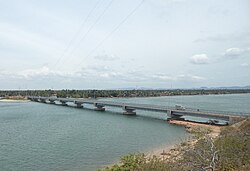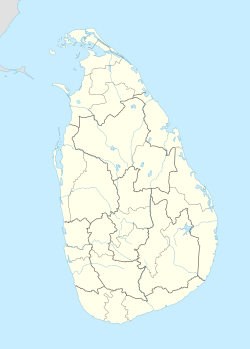world.wikisort.org - Sri_Lanka
Kinniya (Tamil: கிண்ணியா, romanized: Kiṇṇiyā; Sinhala: කින්නියා, romanized: Kinniyā) is a town located east coast in Trincomalee District of the Eastern Province of Sri Lanka. It is located about 20 km (12 mi) from the city of Trincomalee and 240 km (150 mi) from Colombo. Located in Sri Lanka's dry zone, the Kinniya region often experiences hot and dry weather with very little precipitation. Kinniya Bridge is the Sri Lanka's longest bridge situated in kinniya, which attracts many tourists in the town. Being located on the Trincomalee Harbour, Kinniya was badly devastated by the massive tsunami that resulted from the 2004 Indian Ocean earthquake.
This article does not cite any sources. (November 2022) |
Kinniya
| |
|---|---|
Town | |
 Kinniya Bridge, Trincomalee District | |
 Kinniya | |
| Coordinates: 8°29′0″N 81°11′0″E | |
| Country | Sri Lanka |
| Province | Eastern |
| District | Trincomalee |
| DS Division | Kinniya Divisional Secretariat |
| Government | |
| • Type | Kinniya Urban Council |
| • Special Commissioner | Secretary (UPFA) |
| Population | |
| • Town | 61,558 |
| • Urban | 35,645 |
History
Kinniya has over 500 years of history. A 400-year-old Grand masjid in Kinniya was reconstructed in 2002 by the Saudi Arabian government. Most of the inhabitants from Kinniya are immigrants from Morocco, Java, Pakistan and Afghanistan. Its name "Kinniya" defines the kinni tree which was the identity of the people of Kinniya once upon a time.
Demographics
Kinniya is a Moorish majority town. The moors are all predominantly, Muslims, there are also small communities belonging to other ethnic groups such as Sri Lankan Tamils and Sinhalese.
Ethnicity identification in Kinniya Urban Council area.
| Ethnicity | Population | % Of Total |
|---|---|---|
| Sri Lankan Moors | 61,869 | 96.01 |
| Sri Lankan Tamils | 2,390 | 4.06 |
| Sinhalese | 245 | 0.40 |
| Other (including Burgher, Malay) | 32 | 0.03 |
| Total | 75,674 | 100 |
Source:statistics.gov.lk.
Religious Identification in Kinniya Urban Council area.
| 2017 | Percentage | |
|---|---|---|
| Islam | 61,880 | 96.01% |
| Hindu | 2,608 | 4.05% |
| Buddhist | 253 | 0.25% |
| Christian | 41 | 0.04% |
| Total | 64,613 | 100.0% |
Source:-Statistics.gov.lk.
Economy
The fisheries sector plays a key role in social and economic life of Kinniya.
Education
Kinniya has well educated structures from all streams such as, Medicine, Law, Engineering, Government Jobs and Academic staffs. Many government and private schools and colleges has been established in the town, Higher education centers also situated for the education purposes, few years back due to the Sri Lankan Civil War it had been suffer education as unable to go to any places for higher studies.
- T/Kinniya Al Aqsa National School
- Kinniya Central College.
- Kinniya Muslim Girls Maha Vid (National School).
- Aligar Maha Vidyalayam.
- TB Jaya Vidyalaya
- Abdul Majeed Vidyalaya
See also
References
External links
- kinniya.net (In Tamil)
На других языках
[de] Kinniya
Kinniya ist eine Gemeinde (Urban Council) in Sri Lanka mit 36.722 Einwohnern (2012).[1] Sie liegt in der Nähe der Stadt Trincomalee an der Ostküste Sri Lankas. Die Stadt wird überwiegend von Muslimen bevölkert.- [en] Kinniya
Другой контент может иметь иную лицензию. Перед использованием материалов сайта WikiSort.org внимательно изучите правила лицензирования конкретных элементов наполнения сайта.
WikiSort.org - проект по пересортировке и дополнению контента Википедии